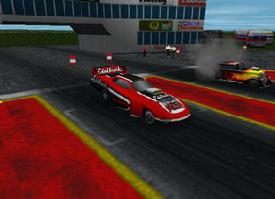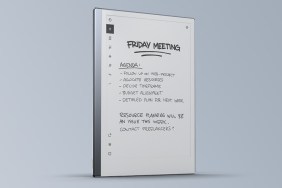American Graffiti minus Harrison Ford.
When Burnout: Championship Drag Racing first appeared at Game Revolution HQ it quickly became the victim of several cruel jokes: “Oh no! Deer Hunter will lose its foothold on the White Trash Market,” “It’s got one control–GO,” or “Gameplay is intense–all ten seconds of it!” Need I admit to you it was all just nervous humor? None of us pencil-necked computer geeks could admit that we simply weren’t qualified to discuss the finer points of the ultimate in machismo, drag racing. Taking up the challenge and putting my manhood on the line, I finally agreed to take this puppy for a test run.
The first thing I have to say is this game is not easy. Or, perhaps the first
thing I should say is that this is not even a game – Burnout is hard
work! Luckily for the folks at Bethesda, the human animal can derive as much
pleasure from a job well done as it can from sitting on the couch playing Duke
Nukem.
The labor begins, of course, in the garage. Before you ever get your cherry machine on the strip, you’ll have to navigate a daunting number of setup options. Now I’m no novice to driving sims — I have a sense for selecting tires, gear ratios, damping, springs and roll bar settings, but Burnout brings back all those scary phrases I used to hear from my older brother and his dip-chewing, Playboy-reading, Hank Williams-listening buddies in my parent’s garage: manifold, compression ratio, bore, stroke. Damn. I can smell the Wintergreen Skoal and feel the humiliation of a Melvin to this day. Thankfully, Burnout does not simulate the sibling abuse my early-childhood experience suggests is the reality of garage decorum.
What it does simulate is eighth-mile and quarter-mile sportsman class drag racing for more than twenty car types–from the 1934 Ford Roadster to the 1995 Corvette. Just like the real deal you first estimate your dial-in, burnout, pre-stage, stage and even deep-stage if you want. Players can race tournament-style elimination Pro Tree or Full Tree and the handicapped or “bracket” nature of the sim means you can compete against your Internet friends, regardless of your favorite car chassis and engine.
On my first outing I took control of the classic ’55 Chevy. Holding the line-limiter and mashing the accelerate key to the plastic (you know, pedal to the metal) delivered the requisite smoking tires. Nice burnout! Then I rolled up to pre-stage. Good. Now stage. Fine. I’m eyeing the Christmas Tree and admiring the nice 3Dfx graphics. Amber, Amber, Amber, GO! The engine is alive, she’s talking to me! Approximately 7.5234 seconds later I found myself careening head-first into the guard-rail. To add insult to injury, the AI driver was courteous enough to ram me from behind. First lesson: don’t use a keyboard with this game–a driving wheel and pedal setup is a necessity. After many more crashes and even more pathetic times, I went searching for help.

Thank God I quickly found Tim McArthur and The Simulated Hot Rod Association (www.shra.com). The SHRA provides a top-notch Burnout users forum as well as organized online tournaments (winners even get their results and names printed in the Bible of Americana, Hot Rod Magazine). Now being the rookie that I am, I never dared enter a real competition against the big boys at SHRA, but I did pick up a few tips. By meeting a few experts and following their e-mailed advice I was eventually able to hold my own against the computer AI on a reasonable difficulty setting. After a few days my roommates even started to notice a change in my voice (a few octaves deeper) and walk (apparently I’ve developed quite a swagger).
From my (albeit unschooled) perspective, there are only a few things that
detract from the overall Burnout experience. The first and foremost is
the relatively detailed, but still inadequate manual. Since this title is such
a ‘niche’ product, Bethesda really should have spent more time explaining both
the rules of the sport and the garage/setup options. If they had done so, the
game might do a lot better at creating new fans. As it is stands now, you’ve
got to already know something about drag racing and car setups to fully enjoy
this title. The second problem is some curious omissions in the setup options
themselves: I was surprised to find no turbo or superchargers, no nitrous oxide,
minimal suspension settings, limited fuel options, and the inability to adjust
ride height. For some reason, Burnout also lets you mix and match parts
it shouldn’t–perhaps this is a holdover from Bethesda’s X-Car
Experimental Racing? On the track itself I never did see any AI cars hit
the guardrails (unless I encouraged them to) and for some reason in the race
results, elapsed time (ET) was not separated from reaction time (RT). As far
as overall presentation goes, there is no announcer or crowd sounds, the game
(gasp!) lacks a dashboard view (you watch your car from a follow cam and can
customize the gauges that appear on screen) and there are some annoyingly terrible
FMV sequences between races (fortunately they can be turned off).
Like most good driving simulations, Burnout: Championship Drag Racing is anything but simple fun for the casual gamer. It’s safe to say that if you don’t know a camshaft from a clutch can, if you thought diapers were just for babies, or if the phrase “two-step” brings only dancing to mind, then this hyper-realistic simulation of drag racing probably isn’t for you. On the other hand, Burnout is sure to please long-time fans of the sport. Word has it that dashboards are due in the next patch, so check out Bethesda’s website for the latest updates: www.bethsoft.com.
-
+ Realistic Feel
-
+ Good graphics
-
- Repetitive; boring
-
- Needs better manual
-
- No dashboard view
-
- Needs more cars







